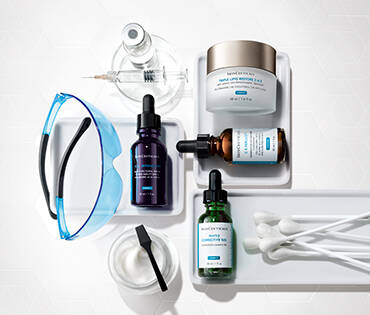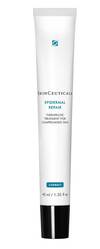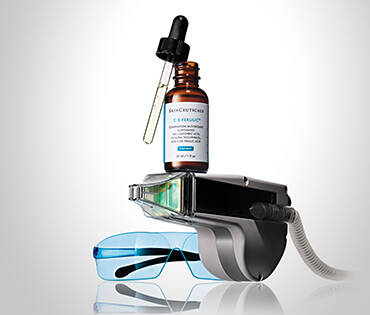Deep Chemical Peel
HELPS ADDRESS:
- Pigmentary disorders (PIH, sun damage, freckles)
- Inflammatory disorders such as acne and rosacea1
- Scarring (acne scars, surgery scars, etc)
- Superficial and medium to deep wrinkles and lines
- Pre-cancerous lesions (actinic keratoses)
AVERAGE DOWNTIME: Two full weeks of staying indoors, avoiding all pro-inflammation and sun exposure. FIND A SKINCARE PROFESSIONAL NEAR YOU >
DEEP CHEMICAL PEEL AT A GLANCE
WHAT IT DOES: A deep chemical peel, classification includes compounds of trichloroacetic acid (TCA) in concentrations of 50% or above and blends containing 88% phenol.2 Because phenol peels were the first deep chemical peel, deep chemical peels are sometimes referred to as “phenol peel”. Deep chemical peels involve the use of these acids to cause the destruction of the epidermis, reaching as far as the mid reticular layer of the dermis. For the most part, a deep chemical peel will cause protein coagulation, commonly referred to as “frosting.”3 Like many other aesthetic modalities such as lasers or radiofrequency devices, a deep chemical peel also works on the principle of controlled wounding to destroy unwanted tissue while also stimulating the body’s natural wound response to increase the production of collagen, elastin and glycoglycosamines (GAGs) such as the water-retaining hyaluronic acid.
WHAT YOU NEED TO KNOW: A deep chemical peel or phenol peel is not recommended for patients with darker skin tones as there is significant risk of scarring and the activation of surrounding melanocytes resulting in severe and prolonged hyperpigmentation. Patients with darker skin tones should consult with an experienced medical professional for advice on other available modalities that may achieve similar results to a deep chemical peel.
CHAT WITH A LICENSED AESTHETICIAN NOW >

FEATURED PRODUCT
Epidermal Repair
THE CHEMICAL PEEL EXPERIENCE
Deep Chemical Peel FAQS
*Always consult your physician before undergoing this procedure.
POST-TREATMENT SKINCARE ROUTINE
**It is recommended to incorporate an at-home skincare regimen after this procedure; always consult with your physician before using a regimen for individual at-home advice.
**Follow all product use instructions and warnings.
***If irritation occurs, discontinue use; if irritation persists, consult your physician.
****These products have not been tested with a deep chemical peel treatment.
DISCOVER PROFESSIONAL TREATMENTS
2 https://www.actasdermo.org/es-chemical-peeling-a-useful-tool-articulo-S1578219017300513
3 https://www.actasdermo.org/es-chemical-peeling-a-useful-tool-articulo-S1578219017300513
4 https://www.ncbi.nlm.nih.gov/pmc/articles/PMC6122508/#:~:text=Currently%2C%20superficial%20peels%20largely%20comprise,recently%2C%2040%25%20mandelic%20acid.
5 https://www.ncbi.nlm.nih.gov/books/NBK547752/
6 https://www.sciencedirect.com/science/article/abs/pii/S0733863505702813?via%3Dihub
7 https://www.plasticsurgery.org/cosmetic-procedures/chemical-peel/deep#:~:text=Deep%20chemical%20peel%20recovery,-Patients%20typically%20can&text=Deep%20chemical%20facial%20peels%20will,for%20up%20to%20three%20months.
8 https://www.plasticsurgery.org/cosmetic-procedures/chemical-peel/deep#:~:text=Deep%20chemical%20peel%20recovery,-Patients%20typically%20can&text=Deep%20chemical%20facial%20peels%20will,for%20up%20to%20three%20months.
9 https://www.actasdermo.org/es-chemical-peeling-a-useful-tool-articulo-S1578219017300513
10 https://www.ncbi.nlm.nih.gov/books/NBK547752/
11 https://www.plasticsurgery.org/cosmetic-procedures/chemical-peel/deep
12 https://www.ncbi.nlm.nih.gov/pmc/articles/PMC6122508/#:~:text=Currently%2C%20superficial%20peels%20largely%20comprise,recently%2C%2040%25%20mandelic%20acid.
13 https://www.verywellhealth.com/chemical-peel-7093529



.jpg?sw=370&sh=315&sm=cut&q=70)

.jpg?sw=370&sh=315&sm=cut&q=70)

